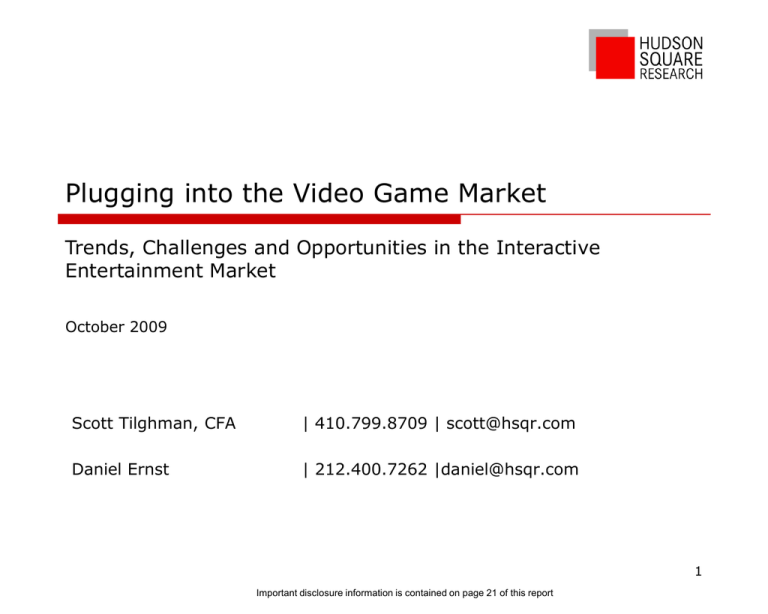
Plugging into the Video Game Market
Trends, Challenges and Opportunities in the Interactive
Entertainment Market
October 2009
Scott Tilghman, CFA
| 410.799.8709 | scott@hsqr.com
Daniel Ernst
| 212.400.7262 |daniel@hsqr.com
1
Important disclosure information is contained on page 21 of this report
Hudson Square Research, Inc.
Formed in August 2004, Hudson Square Research, Inc. is a New York based
institutional equity research boutique and New York registered Investment Advisor
focused on the technology, media, telecommunications, and consumer sectors.
FUNDAMENTAL RESEARCH
Hudson Square provides fundamental Buy, Sell, Hold research employing traditional
top-down and bottom-up methodologies for valuation and risk assessment.
PORTFOLIO APPROACH
Hudson Square employs a unique integrated portfolio approach to coverage
including hardware, software, semiconductors, service providers, and retailers from
Kyoto, Japan to Framingham, Massachusetts.
INDUSTRY CONSULTANTS
With nearly 70 years of collective consultative and research experience, Hudson
Square offers companies a strategic advisory perspective integrating both our crosssector coverage and public market exposure.
2
Important disclosure information is contained on page 21 of this report
Perspective
I rather think the cinema will die. Look at the energy being exerted to
revive it—yesterday it was color, today three dimensions. I don’t give it
forty years more. Witness the decline of conversation. Only the Irish have
remained incomparable conversationalists, maybe because technical
progress has passed them by. – Orson Welles
3
Important disclosure information is contained on page 21 of this report
Summary
OPPORTUNITY EXPANDS
During Fiscal Year 2009 (ending March 2009 – effectively
comparable to Calendar Year 2008) video game software sales expanded 13% Y/Y to $28.7B –
which by comparison is greater than global box office receipts of $27B. Nevertheless, the figure
still represents just a fraction of the $1.1T global media industry. Technology advances are
enabling game makers to tell increasingly realistic interactive stories, that coupled with online
connectivity and accessible control mechanics, greatly expand the opportunity for the games
industry.
CYCLE NOT OVER YET While recent data points to a decline in video game industry sales, we
believe the root is one part economic pressure on consumer spending, and two parts content as
the current slate of new releases faces a tough comparison against the biggest games of last
year. We do not believe the data mark the end of the game cycle.
HOWEVER GROWTH HAS SLOWED Based on our detailed analysis of data from prior cycles
coupled with a view to medium term plans of the platform makers, we forecast the peak for
current generation hardware will occur in FY11 (Mar-11). As with the last cycle, we forecast the
software peak will occur 2 years after hardware, in FY13. However, we expect total industry
sales growth to slow from a 13% CAGR to a 1.9% CAGR through FY13.
NINTENDO REMAINS LEADER With the Wii console, DS handheld, and related software,
Nintendo remains the primary growth driver. Nintendo based hardware and software accounted
for 47% of industry sales in FY09, up from 24% at the start of the cycle in FY06. We forecast
the Wii installed based will expand from 50M at the close of FY09 to 161M by FY13.
FOCUS ON QUALITY Given the dynamics of a slowing market, we believe outperformance will
be driven by company specific execution, and on this metric we continue to like the prospects
for Activision, Nintendo and GameStop.
4
Important disclosure information is contained on page 21 of this report
Games and the Media Landscape
GAMES EXCEED BOX OFFICE
Following a 13% jump in global software
sales, the video game industry has
surpassed the film industry’s box office
receipts.
In FY09 (ending March 09 –
effectively
comparable to CY08), core video game
software sales reached $28.7.5B, vs. $27.0
at the film box office.
Video game software revenues, however,
still represents just a fraction of the $1.1T
global media industry.
AUDIENCE EXPANDS
65% of U.S. households play computer or
video games.
The average game player is 35 years old and
has been playing games for 13 years.
The average age of the most frequent game
purchaser is 40 years old.
Women over the age of 18 represent 33% of
gamers, vs. boys age 17 or younger at 18%.
In 2008, 26% of Americans over the age of
50 played video games, an increase from
nine percent in 1999.
Sources: Company data, Hudson Square Research
5
Important disclosure information is contained on page 21 of this report
FY10 Market Down 19% Y/Y so far
US Game Industry Sales
6,000
70%
60%
50%
40%
30%
20%
10%
0%
-10%
-20%
-30%
-40%
5,000
4,000
Y/Y
Total Sales $M
3,000
2,000
1,000
Jan-08
Feb-08
Mar-08
Apr-08
May-08
Jun-08
Jul-08
Aug-08
Sep-08
Oct-08
Nov-08
Dec-08
Jan-09
Feb-09
Mar-09
Apr-09
May-09
Jun-09
Jul-09E
Aug-09E
Sep-09E
Oct-09E
Nov-09E
Dec-09E
U.S. Market Down 19% Y/Y
Based on NPD data, the U.S. market is down
19% Y/Y during FY10 YTD.
Hardware sales are down 25.8%. Accessory
sales are down 11.4%. Software sales are
down 16.7%.
International data points to a similar
experience in both Europe and Japan.
While we expect upcoming titles and the
recent hardware price cuts will spur second
half sales, many analysts have suggested
the current cycle is over.
As we discuss later in this presentation, we
do not believe the cycle is over, we believe
the recent downturn is the result of 1) very
tough comparisons against titles like GTA
and Mario Kart and 2) the economy with
unemployment approaching 10%
Total $M
Y/Y
U.S. Market FY10 YTD Y/Y
0%
-5%
Software
Hardware
Access.
Total
-10%
-11%
-15%
-20%
-17%
-19%
-25%
-30%
-26%
Sources: NPD, Hudson Square Research
6
Important disclosure information is contained on page 21 of this report
Game Cycle History Points to Continued Growth
SOFTWARE PEAK IN YEAR 6
In the last cycle, combined software sales
peaked in FY05 at 368.1M units; Grand Theft
Auto San Andreas (October 2004), and Halo 2
(November 2004) were released in FY05.
Last Gen Hardware & Software Units
35
400
350
30
300
25
250
20
200
15
150
10
100
5
50
-
FY00 FY01 FY02 FY03 FY04 FY05 FY06 FY07 FY08 FY09
Hardware
Software
Total Hardware & Software Units
120
900
800
100
700
80
OVERLAPPING CYCLES PROVIDE SUPPORT
Even as the last gen cycle peaked, the total
market slowed but did not decline as
overlapping cycles, including handheld games,
provided support.
For instance, in FY05 as the PS2 fell 20% Y/Y,
total PlayStation software units rose 5%.
Software Units M
LAST CYCLE HARDWARE PEAK IN YEAR 4
Between FY00 and FY09, 186.8M last gen
consoles (PS2, GameCube and Xbox) were
sold. In addition, a fourth console, the Sega
Dreamcast sold over 10M units, though the
console was discontinued in 2001.
Sony’s PS2 dominated with 76% of the market
followed by Microsoft’s Xbox with 12% and
Nintendo’s GameCube with 11%.
Combined hardware sales in the last cycle
peaked in FY03 at 32.8M units.
Hardware Units M
600
500
60
400
40
300
200
20
100
-
FY00 FY01 FY02 FY03 FY04 FY05 FY06 FY07 FY08 FY09
Hardware
Software
Sources: Company data, Hudson Square Research
7
Important disclosure information is contained on page 21 of this report
Current Hardware Peak in FY11, Software Peak in FY13
Annual Console Sales
35
30
25
Units M
CURRENT CYCLE SHOULD EXTEND
Assuming the same patterns hold true from the
last cycle, we would expect hardware sales to
peak in FY11 at 53.6M units and software sales
to peak in FY13 at 633.5M units.
We forecast the installed base of current gen
consoles (Wii, Xbox 360 and PS3) will grow
from 103.4M at the close of FY09, to 296.3M by
the close of FY13.
We note our forecast
represents 58.6% growth over the installed
base of last gen consoles.
20
15
10
5
0
FY06
FY07
FY08
PS3
FY09
FY10E FY11E FY12E FY13E
Xbox 360
Wii
SOFTWARE HAS ROOM TO GROW
We forecast the current gen software market
will expand from 412M games in FY09 to 633M
games in FY13.
As with the last cycle, attach rates have already
peaked, as early adopters of the consoles were
by nature more avid players of games. Attach
rates peaked at 4.62 games per console per
year in FY08, and were 3.99 in FY09.
We forecast attach rates will fall to 2.14 in
FY13.
Sources: Company data, Hudson Square Research
8
Important disclosure information is contained on page 21 of this report
Software Attach Rates Shift Up
NINTENDO
Annualized attach rates on the GBA at 0.9x
were 17% higher than for the Game Boy, and
at 1.4x, the DS is running 49% higher than
the GBA did.
Annualized attach rates on the GameCube
were 45% higher than rates on the N64, and
at 3x, the annualized attach rate on the Wii
is running 54% higher than on the
GameCube.
We attribute Nintendo’s attach rate to its
success in broadening the appeal of gaming
across the family (e.g. Mom and Dad buy
games like Wii Fit and Tiger Woods for
themselves in addition to games for the
kids).
SONY
While we believe Sony’s software sales have
been overshadowed by the larger installed
base of the Xbox 360 and the Wii, the PS3 is
also demonstrating a higher level of attach
rates than its predecessor with attach rates
up 37% relative to the PS2 on a cumulative
basis.
Sources: Company data, Hudson Square Research
9
Important disclosure information is contained on page 21 of this report
China a Vast but Hard to Tap Market
NO CONSOLE MARKET
Largely for fear of piracy, first party
platforms have largely ignored the Chinese
game market. Because consoles are often
sold at a loss with profits made from
software and royalties, the degree of piracy
in China makes the console market
effectively untenable.
INTERNET / GAME CAFÉ BOOM
With a low rate of PC ownership, the
Internet café has become the primary
distribution point for games in China.
According to Pearl research, China’s online
game market rose 63% Y/Y in CY08 to
$2.8B.
But, China is banning foreign investment in
online games.
YOUNG MARKET
According to Pearl, 70% of China’s 298
million Internet users are under the age of
30, and 65% of those have played online
games.
10
Important disclosure information is contained on page 21 of this report
PC Game Market
BROAD PLATFORM
The key advantage of the PC as a games
platform is its virtual ubiquity.
Where there are just over 100M current
generation console owners there are over 1B
PCs in use globally.
In many markets like China, the presence of
Internet
cafés
makes
online
gaming
accessible to virtually anyone.
NICHE MARKET
However, while PCs are more prevalent than
game consoles, PC gaming has a few
limitations.
A high-end gaming PC can cost as much as
$4,000, vs. the most expensive game
console at $399.
We estimate the core PC market at $3.9B
globally (excluding MMOs).
Including MMO and other digital distribution /
pay to play revenue streams, the PC Gaming
Alliance pegs the total PC game market at
$10.7B.
Sources: Company data, Hudson Square Research
11
Important disclosure information is contained on page 21 of this report
MMO Game Trends
WOW DOMINATION
Prior to the introduction of World of
Warcraft (WoW), the market for MMO
games was limited to a few million players,
but since 2004, the market has grown to
17.9M subscribers, with WoW holding a
64% share.
Over the last two years there have been
several high profile MMO game launches,
though none of those appear to have
established a material subscriber base, and
two of those, Tabula Rasa, and Hellgate
London shut down within a year of launch.
Because of the network effect (as the
product base grows, the product becomes
more useful to any one individual), we
believe WoW is likely to maintain its
leadership position for the foreseeable
future.
We estimate MMO revenues totaled $1.5B in
FY09, up from $1.4B in FY08, although we
note that market research firm DFC pegs
the total online gaming market at $5.7B.
Sources: Company data, Hudson Square Research
12
Important disclosure information is contained on page 21 of this report
Mobile Phone Trends
BRICKBREAKER
Global market for mobile phone games
reached an estimated $3.5B in FY09.
Growth in the industry appears to have
fallen short of earlier expectations.
Limitations of handset technology, and a
generally restrictive distribution mechanism
likely explains the shortfall.
iGAME
Apple is solving two key hurdles to mobile
phone gaming: 1) customizing every game
for every device; and 2) distribution
challenges.
The iPhone/iPod Touch appear to be
significantly altering the mobile phone
game market.
Still, control mechanics limit the scope of
games that can be effectively played. For
instance, using tilt to control games tilts
the screen away from the player's field of
vision.
And, using onscreen virtual buttons that
leverage Apple's touch sensitive screen also
reduces the available space for depicting
the game itself.
Sources: Company data, Hudson Square Research
13
Important disclosure information is contained on page 21 of this report
Used Games Not Going Away Just Yet
NOT GOING AWAY JUST YET
Potential exists for an entirely digital
model.
But, a variety of technological and
structural barriers prevent that transition
this cycle, and might very well extend the
physical media into the next cycle.
We estimate the used game software
market grew 30% Y/Y to $5.2B in FY09 –
adding roughly 18% in retail sales to our
estimate for the global new game software
market.
COUNTERCYCLICAL MARKET
The market for used games tends to be
countercyclical to the hardware market.
Market serves both core gamers looking for
content, and value-oriented gamers.
The new market has expanded faster than
the used market, those increases were
driven largely by hardware. Therefore in
the medium term, we expect used market
growth will outpace the industry.
Sources: Company data, Hudson Square Research
14
Important disclosure information is contained on page 21 of this report
Digital Distribution
ANECDOTAL To date, statistics on the digital game distribution revenues have been largely
anecdotal. While the individual milestones provide a compelling argument, in our view, there
has not been enough progress to paint a meaningful picture.
In June, Microsoft reported over 21M Xbox Live registered accounts, up about 9M from
June-08.
In September, Sony noted increasing momentum with its online services with 20M
registered accounts, up 12M since the start of the year.
For FY09, Electronic Arts reported digital revenues (ex mobile sales) contributed $193M in
sales, comprising 4.6% of total revenues, up 3% Y/Y and 55% since FY06.
Take-Two launched the first of two Xbox 360 exclusive expansion packs for GTA IV on
April 29. Titled The Lost and Damned, 1M downloads have been reported to an applicable
installed-base of 8M Xbox 360 GTA IV owners. .
As of May, about 54M downloads have been reported for the Guitar Hero franchise, and
as of October, 50M for Rock Band.
MOBILE APPS STORES With the launch of the Apple iPhone / iTouch software application
store in July 2008, the Nintendo DSi Shop and Blackberry App Store in April 2009, and Nokia’s
Ovi Store in May, there is growing momentum for digital games in the mobile world – a market
largely geared for short time-filler games where digital distribution likely makes more sense in
our view.
ONLIVE One of the most intriguing new concepts we have seen in some time was the unveiling
of OnLive’s plans to launch an all digital, console free game platform. While we believe the
service will likely encounter material technical obstacles in the field, the service does portend to
completely change the game industry – removing the first-party platforms from the picture
(though we doubt Microsoft, Sony, and Nintendo will merely roll over).
15
Important disclosure information is contained on page 21 of this report
Audiences Fragment
Between 1979 and 2007, the prime time
market share of the 3 major television
networks fell from over 90% to under
40% as cable networks grew and
audiences fragmented.
The core market of consoles and portables
accounted for 76% of game software
sales in FY09.
While new platforms like the iPhone and
Facebook potentially open the game
market to new audiences, we believe
significant risk exists that those channels
could cannibalize the core game market
and fragment audiences in a similar
fashion.
Prime Time Network Share
100
90
80
70
60
50
40
30
20
NBC
CBS
ABC
10
0
Sources: Company data, Nielsen, Hudson Square Research
16
Important disclosure information is contained on page 21 of this report
Market Remains Optimistic
Despite the sales weakness, the video game market has performed very well. Globally the
stocks are up 16.2% YTD, and the U.S. publishers are up 38.3% vs. 36.8% for the NASDAQ
and 15.8% for the NIKKEI.
We believe the disconnect is driven by continued expectations that the video game market will
resume growth in 2010, and more importantly by expectations that the game market will hold
an increasingly important role within the media landscape.
Consensus expectations are for the video game group to grow sales by 8% in CY10 and
earnings by 25%.
Price
YTD
10/16/09
LAST Return
Market
Cap
(Mil)
Sales (Mil)
2009E
2010E
EPS
2009E 2010E
P/S
2009E 2010E
P/E
2009E 2010E
NORTH AMERICA ($)
Activision Blizzard PF $
Electronics Arts
Take-Two
THQ
U.S. GROUP
12.34
20.56
11.18
5.62
42.8%
28.2%
47.9%
34.1%
38.3%
15,879
6,640
869
377
23,765
4,615
4,225
1,005
866
10,710
5,162
4,458
1,309
879
11,808
0.64
0.72
(0.59)
(0.34)
0.78
1.18
0.44
0.30
3.4
1.6
0.9
0.4
2.2x
3.1
1.5
0.7
0.4
2.x
20.8
28.6
NA
NA
22.6x
19.3
17.4
25.4
18.7
18.9x
¥
1.67
1.79
0.95
23.93
1.24
2.25
-16.5%
-21.7%
-2.7%
-29.1%
19.3%
-20.4%
-11.8%
112
256
237
3,390
350
259
4,605
104
296
388
1,610
409
170
2,977
97
303
400
1,659
397
184
3,041
184.1
53.0
25.1
2,567
23.2
99.6
154.5
126.6
40.0
2,944
64.1
150.1
1.1
0.9
0.6
2.1
0.9
1.5
1.5x
1.2
0.8
0.6
2.0
0.9
1.4
1.5x
9.0
33.7
37.9
9.3
53.2
22.5
11.3x
10.8
14.1
23.7
8.1
19.3
15.0
9.4x
Gameloft
€
Infograme
Ubisoft
EUROPEAN GROUP
3.83
0.71
13.10
155.3%
-82.4%
-6.1%
22.3%
282
9
1,229
1,520
123
349
1,060
1,532
136
371
1,091
1,597
0.09
(1.36)
0.61
0.15
(0.23)
0.61
2.3
0.0
1.2
1.x
2.1
0.0
1.1
1.x
42.6
NA
21.5
23.7x
25.5
NA
21.5
22.1x
JAPAN (¥)
Capcom
Konami
NamcoBandai
Nintendo
SegaSammy
Square Enix
JAPANESE GROUP
EUROPE (€)
Sources: Company data, FirstCall, Hudson Square Research
Note: Yen figures in billions
Important disclosure information is contained on page 21 of this report
17
Increasing Entry, Fewer Exits
Venture financing appeared to have
bottomed in 1Q09 at $3.19B, and
increased to $3.67B in 2Q09.
Video game related financing appear to be
faring well with more than a dozen double
digit financings over the last 18 months
including: Big Fish, Bigpoint, Outspark,
Onlive, Playfish, Pop Cap, Realtime, and
Zynga.
While M&A appears to be heating up, the
aggregate M&A market remains subdued
with YTD transactions down 56% Y/Y.
Similarly their have been relatively few
transactions in the games space which
have included Bighole, Cryptic, and ID.
Two notable deals were largely distressed
situations; Eidos and Midway.
Sources: Company data, NVCA, Bloomberg , Hudson Square Research
18
Important disclosure information is contained on page 21 of this report
Summary-Opportunities and . . .
Broad and growing footprint of gaming devices – installed and portable
consoles, smartphones, and PCs
Publishers enhancing development across product segments and
manufacturers-not the one horse race of the last gaming cycle
Content remains the primary industry driver for the next several years
Software attach rates are up versus previous cycle
Expanding demographic – gaming is no longer constrained to a male teen
target group
Consumers voting with their spending – pushing gaming ahead of the box
office as a preferred means of entertainment
Increasing broadband penetration complemented by a rapidly increasing
percentage of networked homes
Strong appetite for gaming apps – 15K active (#1 category) of 85K available
as of September 28, according to Apple
19
Important disclosure information is contained on page 21 of this report
Summary-Challenges
Audiences may be fragmenting
Lack of platform standardization increases development costs and risks
Consumers place a relatively high trade-in value on packaged/hard copy
media
International piracy remains a key concern for developers/publishers.
Digital content, albeit growing, is still a small portion of the traditional
console-based gaming industry
Bandwidth and network latency remain limiting factors
Natural strategic buyers are increasingly concentrated
20
Important disclosure information is contained on page 21 of this report
Regulatory Required Disclosures
ANALYST CERTIFICATION AND IMPORTANT DISCLOSURES:
The Research Analyst(s) principally responsible for the analysis of any security or issuer included in this report certifies that the views expressed
accurately reflect the personal views of the Research Analyst(s) about the subject securities or issuers and certifies that no part of his or her
compensation was or is or will be, directly or indirectly, related to the specific recommendations or views expressed by the Research Analyst(s) in this
report.
Hudson Square Research, Inc. has not previously received compensation, nor does it plan to solicit business from the subject company(ies) of this
report. Hudson Square Research Inc, is not a broker dealer and therefore, among other things does not make a market for the securities recommended
in the report. Hudson Square Research, Inc. is a New York registered investment advisor. Neither the analyst(s) responsible for preparing this report,
nor Hudson Square Research, Inc. hold a position in the securities recommended in this report.
Ratings Explanation
BUY: Over the next twelve months, we believe this stock should outperform the average total return of the stocks in the analyst’s coverage universe.
HOLD: Over the next twelve months, we believe this stock should perform in line with the average total return of the stocks in the analyst’s coverage
universe.
SELL: Over the next twelve months, we believe this stock should underperform the average total return of the stocks in the analyst’s coverage
universe.
Copyright, User Agreement and Other Information Related to This Report
Copyright 2009 Hudson Square Research, Inc. All rights reserved. Receipt of this report constitutes your acknowledgement and agreement to the
following terms: This research report is prepared for the use of Hudson Square Research, Inc. Institutional investor clients and may not be
redistributed, or disclosed, in whole or in part, without the express written consent of Hudson Square Research, Inc. The information within this report
(other than disclosure information relating to Hudson Square Research, Inc. and its affiliates) was obtained from various sources and we do not
guarantee its accuracy. Hudson Square Research, Inc. makes no representations or warranties whatsoever as to the data and information provided in
any third party referenced source and shall have no liability or responsibility arising out of or in connection with any such referenced source. This
research report provides general information only. Neither the information nor any opinion expressed constitutes an offer or an invitation to make an
offer, to buy or sell any securities or other investment or any options, futures or derivatives related to such securities or investments. It is not intended
to provide personal investment advice and it does not take into account the specific investment objectives, financial situation and the particular needs of
any specific person who may receive this report. Investors should seek financial advice regarding the appropriateness of investing in any securities,
other investment or investment strategies discussed or recommended in this report and should understand that statements regarding future prospects
may not be realized. Investors should note that income from such securities or other investments, if any, may fluctuate and that price or value of such
securities and investments may rise or fall. Past performance is not necessarily a guide to future performance. Any information relating to the tax status
of financial instruments discussed herein is not intended to provide tax advice or to be used by anyone to provide tax advice. Investors are urged to
seek tax advice based on their particular circumstances from an independent tax professional. Foreign currency rates of exchange may adversely affect
the value, price or income of any security or related investment mentioned in this report. In addition, investors in securities such as ADRs, whose values
are influenced by the currency of the underlying security, effectively assume currency risk.
21
Important disclosure information is contained on page 21 of this report






